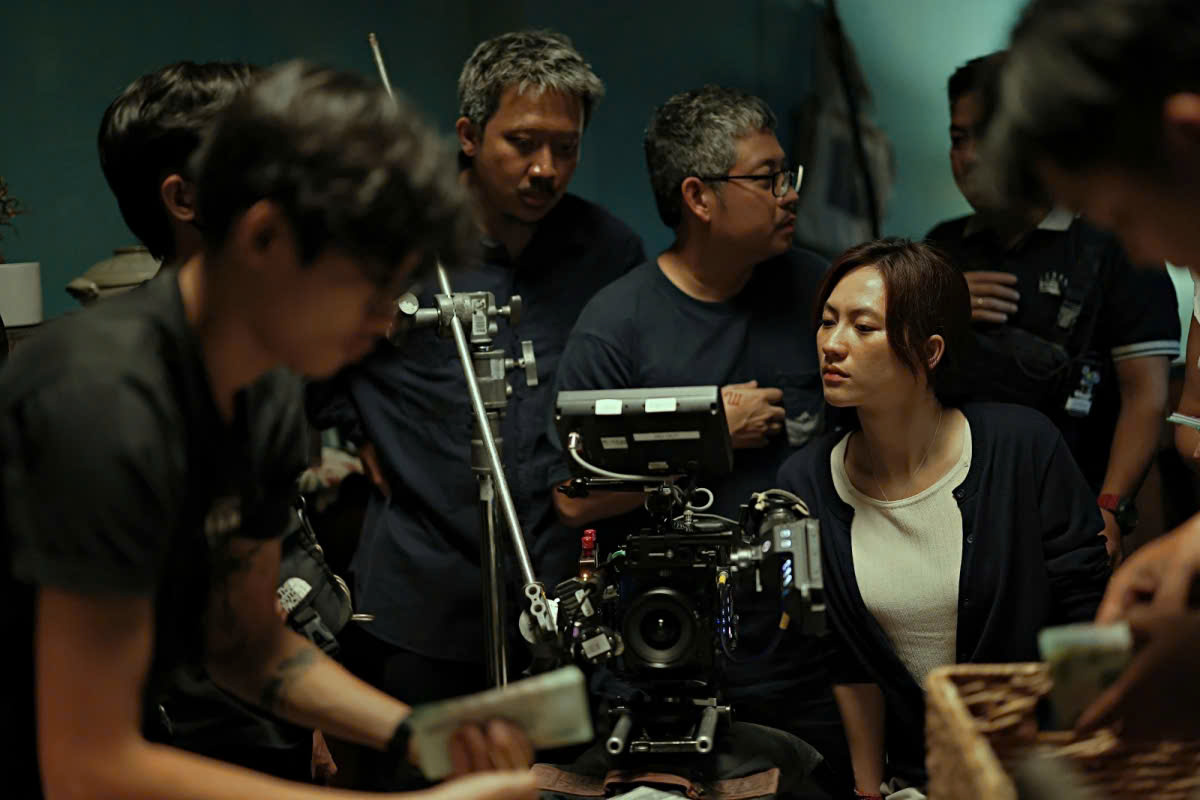Over the years, the Vietnam Film Promotion and Development Association (VFDA) has been recognized and evaluated as a social and professional organization with great efforts in promoting the development of Vietnamese cinema and integrating with international cinema. Continuing to assume the position of President of VFDA, what is the biggest pressure for you?
- The biggest pressure for us is how to make the following year's activities more effective than the previous year, and the following event more creative and better than the previous one. And the Association's goal is to contribute to the sustainable development of Vietnamese cinema, linking the development of the film industry with the service sectors, local economy, especially tourism.
In recent years, VFDA has participated in organizing many major film events, notably the Da Nang Asian Film Festival. It seems that VFDA's ambition is to help Vietnamese filmmakers have more opportunities to interact with international filmmakers and learn more from them. From your perspective, how do you evaluate the response of domestic filmmakers to international events?
- The Da Nang Asian Film Festival (DANAFF) has indeed developed and spread faster than we initially expected. DANAFF I (2023) was voted as one of the 10 outstanding cultural events in 2023, while DANAFF II (2024) was assessed to be more professionally organized, larger in scale and of higher professional quality.
That lies in the quality selection of films for the competition, the diverse films included in the introduction program (panorama), and the professional activities (seminars, discussions, workshops...) which are very in-depth and effective.
In particular, DANAFF II attracted famous filmmakers, leading prestigious experts from the world (from Cannes, Berlin), Asia (from Busan) and Vietnam to participate as judges, speakers or workshop instructors.
Thanks to that, it is true that Vietnamese filmmakers, artists, and young people attending the workshops have had the opportunity to interact and learn a lot, helping them confidently attend international film events.
The competition criteria of DANAFF are very clear: The Asian Film section is selected for the competition of art films, while the Vietnamese Film section is selected for the competition of the best Vietnamese films of the year. Therefore, filmmakers from all Vietnamese film “genres” have a suitable game, and the results of the 2 DANAFFs have proven that our orientation is correct.

We are talking about the film industry, expecting the film industry to contribute to GDP like Korea. However, in 2024, most Vietnamese films released in theaters are still criticized for their scripts and suffer losses. The fluctuations are few, mainly focusing on a few names like Tran Thanh, Ly Hai... What can we expect from a film market that is still small and seasonal, in your opinion?
- The quality of Vietnamese films is indeed uneven, but overall there has been a clear improvement. Compared to the early 2010s, the “disaster” or “nonsense comedy” (as the press often used) films that were so popular back then have now almost been “liquidated”!
Even with Tran Thanh, each film is better than the previous one. As for Ly Hai's Lat Mat 7, for me, it was a surprise in terms of quality. Before that, I had watched most of the films in the Lat Mat series. I saw that Ly Hai had changed a lot.
Film critics are dividing the Vietnamese film market into: Tran Thanh, Ly Hai and the rest. Accordingly, the “rest” has a huge gap compared to the revenue of Tran Thanh’s Mai film, which earned 500 billion VND, or Ly Hai’s 300 billion VND. What is your assessment of the huge gap between film producers, and in your opinion, what is the key point leading to the loss of the “rest”?
- Coincidentally, both Tran Thanh and Ly Hai are amateur directors. But they are the writers and directors. I think that, in addition to scripting techniques, telling an attractive story requires charm, experience, and understanding the needs and tastes of the audience. Ly Hai and Tran Thanh are very strong, attracting audiences "surpassing" their seniors.
But in fact, to have "trillionaire" directors like Tran Thanh and Ly Hai, we need to be fair, the Vietnamese film market has been built for decades by directors and producers worth hundreds of billions like Victor Vu, Charlie Nguyen, then Phan Gia Nhat Linh, Bao Nhan and Nam Cito, Le Thanh Son, Vo Thanh Hoa... I hope that in the next few years, there will be new factors creating new breakthroughs.
Vietnamese films are still considered to have too many weaknesses. Weak scripts. Weak technology, weaknesses in personnel, talent... VFDA has a role in consulting, advising, and proposing to the authorities on building policies and strategies for film production strategies, and strategies for developing the film industry. In your opinion, where should we start investing with the highlight, what is the biggest key point that needs investment?
- First of all, VFDA is a social-professional organization, not specialized in economics and finance, so its opinions on where to invest to develop the film industry are not necessarily of interest. Accordingly, we do not know whether our voices will be heard by the competent authorities or not.
But there is one thing I have seen since I became Director of the Cinema Department, that is the method of ordering film production from the state budget has many shortcomings, leading to inefficiency. The Cinema Department has proposed a cooperation plan between the state and the private sector in film production and distribution, and the successful result is the film I See Yellow Flowers on the Green Grass. The film not only succeeded with the highest revenue ever for a commissioned film, but also opened a trend of making films about deep, emotional childhood memories that have won over audiences, replacing the blockbuster films of the time thanks to "shock and sex".
Unfortunately, that cooperation model seems to be closed now by certain regulations, while "public-private partnership" is one of the important factors for developing the film industry.
Second, I think we need to clearly recognize the decisive role of the "human" factor in the journey of consolidating and developing the internal strength of cinema.
VFDA not only discusses, seeks solutions and directions for the Vietnamese film industry through international conferences but also strives to discover, encourage and support young film talents by creating interesting and meaningful competitions.
For example, in early 2020, VFDA in collaboration with the Motion Picture Association of America (MPA) invited young filmmakers to submit film projects for the Film Pitching Competition - From Script to Screen. VFDA also organized the Green Screen Short Film Competition, which attracted the participation of many young filmmakers. Or in 2023, the online clip creation competition "I LOVE VIETNAM" co-organized by VFDA and MPA attracted young people nationwide to participate, both demonstrating their abilities and promoting the image of Vietnam as a tourist destination and an ideal place for filming.
VFDA's focus on discovering and nurturing talent is the activities in the Da Nang Asian Film Festival (DANAFF). Both DANAFF I and II in 2023 and 2024, Vietnamese films were crowned Best Asian Film (The Children in the Mist in 2023 and Culi Never Cries in 2024). Also within the framework of DANAFF, the "Talent Nurturing" Workshop chaired by VFDA, in coordination with the Autumn Meeting Group, organized annually, was successful, creating a youthful, fresh look and creative spirit for DANAFF.
Reviewing the above series of works, I would like to add that VFDA operates entirely on self-funded funds, and sets its own plans and programs entirely for the benefit of the country and society.
I want to emphasize that the human factor is important and plays a key role, so organizing competitions to discover talents, or developing film human resources by sending hundreds of people to study abroad like in Korea would also be very good. However, in the current 4.0 era, the State should pay attention to training talents and human resources in many forms. The most important thing is to have an incentive mechanism for organizations like VFDA to work together.

Recently, the National Assembly approved the total capital for implementing the National Target Program on Cultural Development for the period 2025 - 2030 at 122,250 billion VND. As for cinema, it will probably be an industry that "eats" a lot of investment money. What is your perspective?
- The film industry is a chain of creation - film production - film distribution and dissemination and building a healthy competitive market - protecting copyrights - reproduction from revenue from the market.
That said, a real film industry will support itself. Look at the developed film industry in the US, not only "supporting" itself but also a giant money-making machine.
To develop the Vietnamese film industry, investment is very important, but in my opinion, the decisive thing is that we must have a strong enough internal film force, in which we first need to harmoniously develop Vietnamese film genres: "mainstream" film genres, commercial film genres, art film genres and independent film genres, because each film genre has its own value and goals.
To do this, the human factor plays a decisive role, because this is the master of the creative and production stages. I have just mentioned the human factor above.
In addition, building a suitable mechanism is also very important. The State needs to maintain and promote public-private cooperation, and clearly define the cooperation mechanism, because this is the key to developing the film industry.
In the case of the film Dao, Pho and Piano, which created a fever in theaters, it was impossible to handle the “proportioning” between the producer and the theater, because according to the new regulations, all revenue must be paid to the budget. Without a public-private partnership mechanism, it is impossible to build a path for the sustainable development of the film industry, because it is not in accordance with the laws of development.
We need clear, transparent sub-law regulations and appropriate mechanisms to promote the endogenous strength of cinema and create resonance between the film industry and related service and economic sectors as well as expand international cooperation - a strength of cinema that is difficult for any other literary or artistic sector to match.
(Posted on the special edition of Labor Weekend Spring At Ty)











